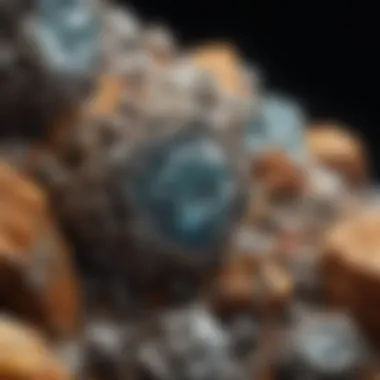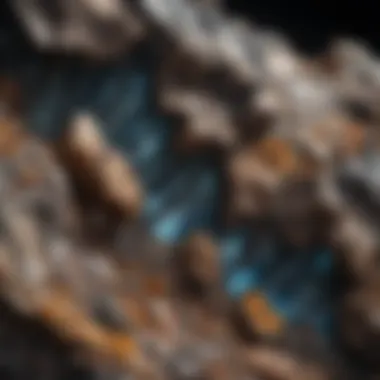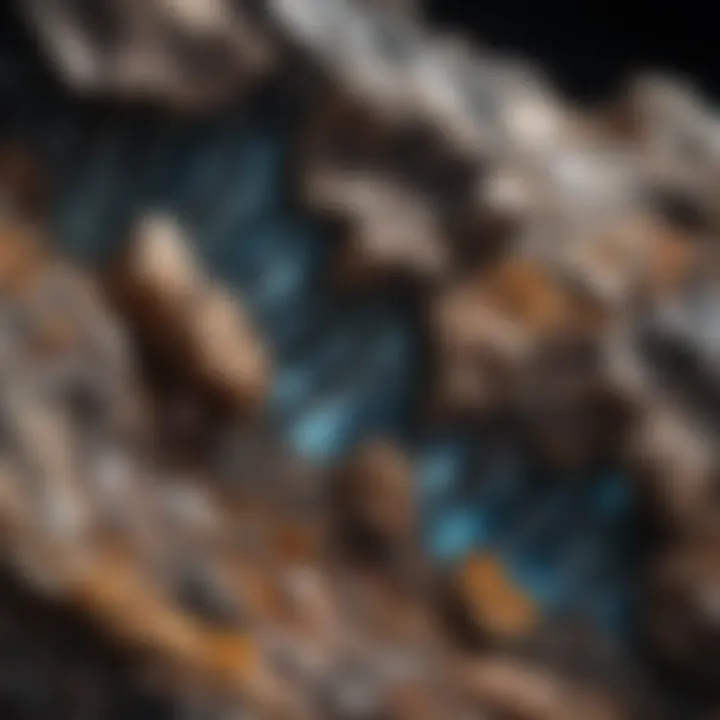The Impact of Microscopy on Geological Studies


Intro
Microscopes are not just lab equipment; they are gateways into the unseen realms of geological materials. For rock and fossil collectors, understanding how microscopy works can unleash a world of treasures hidden at tiny scales. Whether you’re gazing at mineral crystals or studying the intricate details of fossilized remains, the role of microscopy in geology cannot be overstated. It allows for the exploration of textures, structures, and compositions that would otherwise go unnoticed through conventional observation.
With the increasing integration of microscopic analysis in the geological sciences, this piece will delve into how these instruments enhance our appreciation and comprehension of the mineral kingdom. Let’s embark on this exploration, examining not only the technology but also its applications and insights that it brings forth for collectors and enthusiasts alike.
Featured Collectible of the Month
Overview
This month's featured collectible is the microcline mineral, a member of the feldspar family that often exhibits striking color variations and fascinating crystal structures. Beyond its physical beauty, microcline tells a story of geological processes that shape the Earth’s crust.
When viewed under a microscope, collectors can observe the distinct twinning patterns that characterize microcline, alongside the nuances in its crystal growth that hint at its environmental conditions. Understanding these characteristics enriches a collector's knowledge, transforming admiration into expertise.
Historical Significance
Microcline’s significance stretches back to the 19th century when it first caught the eye of mineralogists. Its discovery contributed to the broader understanding of pegmatitic rocks, with collectors during that era often cherishing exceptionally large and well-formed crystal specimens. The interplay between geology and history is palpable, making microcline an essential piece of any geological collection.
As collectors hold these specimens and study them microscopically, they connect with the very fabric of geological time, bringing to light the processes that forged them.
Identification Techniques
Visual Characteristics
Identifying microcline can be quite the adventure! Here are some key visual traits to keep in mind:
- Color: It generally ranges from light green to white, but can also appear in shades of yellow and pink.
- Luster: Typically exhibits a glassy sheen, contributing to its overall appeal.
- Crystal Habit: One might find it presenting as tabular or prismatic crystals, often displaying distinct striations.
Honing in on these characteristics will aid enthusiasts in distinguishing microcline from other feldspar types. The microscopic examination further clarifies its identity with intricate details.
Resources for Identification
Finding reliable resources to aid identification is crucial. Here’s a brief list that can serve collectors in their quest:
- Mindat.org: An extensive database with mineral information and photos.
- Wikipedia: Good starting point for mineraogical backgrounds and terminology.
- Field Guides: Books like "Minerals of the World" can offer insights and visuals on various specimens.
Understanding how microscopy impacts the identification process not only sharpens skills but also fosters deeper connections with the collections.
As advancements in microscopy continue, the tools and techniques used in geosciences promise to enhance our grasp of the geological past and the hidden particulars within our specimens.
Preamble to Geological Microscopy
The world of geology, steeped in layers of time and transformations, reveals secrets that often lie beyond the naked eye. Here, microscopy plays a pivotal role, shedding light on the intricate details found in rocks, minerals, and fossils. This section unpacks the importance of geological microscopy, illustrating how it serves as a bridge between the macro world of landscape and the micro world of mineral structure.
Definition and Importance
Geological microscopy refers to the use of microscopes to study geological specimens, encompassing rocks, minerals, and sediment. This examination allows geologists to uncover vital information about a sample’s composition, texture, and history. In the realm of mineralogy, the microscopic analysis can determine the mineralogy of rocks, providing insights into geological processes and the environmental conditions that shaped them.
- Precision: Microscopy enables precise observation of mineral properties like cleavage, crystal form, and refractive indices.
- Research Development: As we dive deeper into earth science, microwave methods open up avenues for research that were once considered unattainable.
For rock and fossil collectors, understanding these processes isn't just academic; it enhances their ability to classify and appreciate the beauty and complexity of the specimens in their possession. The study of micro-textures can also tell stories of geological upheavals, climates of ages past, and even the existence of life forms that flourished millions of years ago. It underscores the idea that every grain has a tale waiting to unfold.
Historical Context
The evolution of geological microscopy is rooted in a rich history. While the invention of the microscope dates back to the 17th century with pioneers like Antonie van Leeuwenhoek, the application to geology gained traction in the 19th century. It was during this period that scientists began systematically examining thin sections of minerals and rocks.
The work of mineralogists such as Friedrich Mohs and later, researchers like Harry Harold Hess, played a crucial part in emphasizing the importance of microscopic analysis. Actively using polarized light in microscopes unveiled details such as symmetrical arrangements and crystal inclusions that were instrumental in shaping contemporary mineralogy.
"The microscope is a window to the hidden world, revealing details that humankind was not designed to see, yet yearns to understand."
As microscopes evolved, so did their applications in geology. Today, the field benefits from advanced technologies such as scanning electron microscopy and X-ray fluorescence, pushing boundaries further and providing geologists unparalleled insights into Earth's materials.
In summary, geological microscopy is foundational for the exploration and understanding of geological specimens, yielding vital insights into the Earth's past and evolution. Its historical roots enrich its current relevance, making it an exciting and invaluable tool for both professionals and enthusiasts alike.
Types of Microscopes Used in Geology
Understanding the types of microscopes utilized in geology is foundational for anyone involved in the study of rocks and minerals. Microscopes reveal the often hidden aspects of geological samples, allowing for detailed examination of their structures and compositions. This section will dive into three primary types: optical microscopes, electron microscopes, and X-ray microscopes. Each of these tools brings its own strengths and considerations to the table, providing invaluable insights that are essential for research and exploration in geology.
Optical Microscopes
Optical microscopes serve as the first line of defense in geological examination. Utilizing visible light and lenses, these microscopes magnify samples, making them essential for assessing mineral identification and texture at a microscopic level. The simplicity and ease of use make optical microscopes a staple in both field and lab settings.
One primary advantage is their affordability compared to more advanced alternatives. Notably, for rock and fossil collectors, optical microscopes often provide sufficient detail to identify mineral grains, cleavage, and other morphological features without the need for specialized training.
Key Features:
- Light Source: Provides illumination to highlight sample details.
- Simple Preparation: Samples can often be observed as they are, particularly thin sections.
- User-Friendly: Suitable for beginners and experienced geologists alike.


"The optical microscope opens up a world beneath our feet, shedding light on what is often overlooked: the minute intricacies of natural formations."
However, these tools have limitations, particularly in resolution compared to electron microscopes. They cannot reveal atomic structure or very fine details of the sample. Nonetheless, they remain indispensable for initial analyses and educational purposes.
Electron Microscopes
Electron microscopes are a major leap forward in terms of imaging capability. Instead of light, these instruments use electron beams to produce images, allowing them to achieve much higher resolutions. For geology, this means the ability to observe structures at the atomic level, uncovering details that optical microscopes simply cannot.
The two main types of electron microscopes are the Scanning Electron Microscope (SEM) and the Transmission Electron Microscope (TEM). Each serves different purposes:
- SEM: Provides 3D images of surface features and can analyze small areas quickly.
- TEM: Allows for transmission of electrons through ultra-thin samples, revealing internal structures.
The benefits of using electron microscopy for geological samples are significant. It aids in the finer classification of mineral species and delivers even minute data about elemental composition through techniques such as Energy Dispersive X-ray Spectroscopy (EDS).
But it's not all roses; these microscopes are often expensive and require significant training to operate effectively. Furthermore, sample preparation can be quite complex, often involving intricate and a meticulous process.
X-ray Microscopes
Among the more novel approaches in geological microscopy, X-ray microscopes provide unique ways to view samples in three dimensions. They utilize X-ray radiation to penetrate materials, making them suitable for studying heavier mineral specimens without requiring destructive sample preparation methods.
The non-destructive nature of X-ray microscopy is a significant advantage, particularly for precious geological samples. It opens up possibilities for dynamic live imaging, which is immensely helpful when examining the formation processes of minerals or fossils. Another appealing aspect is their ability to provide bulk chemical information, thus allowing for a broader understanding of the sample as a whole, not just surface features.
Considerations:
- Advanced Technology: Generally only found in specialized laboratories.
- Costly Equipment: The price point can be a barrier for smaller institutions.
- Expertise Required: Handling and analysis usually demands a higher level of expertise.
In summary, understanding these various types of microscopes equips rock and fossil collectors with the knowledge to choose the suitable tools for their specific needs while advancing their ability to uncover the stories hidden within geological specimens.
Fundamental Techniques of Geological Microscopy
Understanding the fundamental techniques of geological microscopy is essential for delving deeper into the microscopic world of rocks and fossils. These methods not only enhance the quality of the analysis but also provide the means to uncover details that might elude the naked eye. The precision and care taken in these techniques can significantly influence findings, allowing for accurate mineral identification and geological interpretations.
Sample Preparation
Before any examination can take place, proper sample preparation is paramount. This process involves collecting specimens in a way that preserves their integrity. For instance, when dealing with rock samples, it is vital to ensure that they are free from contaminants and extraneous materials that might obscure microscopic details.
Additionally, the size and shape of the samples should be carefully considered. Ideally, samples should be thin enough to allow light to pass through but thick enough to hold their composition.
Here are some key steps in sample preparation:
- Cleaning: Remove dust, dirt, and any organic materials that could interfere with the analysis.
- Cutting: Use a diamond saw or other precision-cutting tools to achieve the desired thickness.
- Mounting: Once cut, specimens are often mounted on glass slides with a medium that doesn’t alter their properties.
A well-prepared sample sets the stage for effective microscopy, ensuring that the analysis is both reliable and informative.
Staining Techniques
Staining techniques are employed to enhance the contrast of mineral features under the microscope. By applying specific dyes to different minerals, geologists can differentiate between them more easily. This is particularly beneficial when analyzing thin sections of rock, where distinguishing between similar-looking minerals becomes crucial.
Each stain interacts uniquely with various minerals based on their chemical composition. For example:
- Wright's stain can aid in identifying specific phosphate minerals.
- Congo red highlights quartz presence, revealing intricate structures.
The choice of staining method often depends on the particular minerals present in the sample and the information sought. While these techniques can add an additional layer of insight to geological studies, they also require a careful approach, as staining may alter a sample's natural state. Hence, it is vital to use stains judiciously and know their implications when interpreting results.
Thin Sectioning
Thin sectioning is a cornerstone technique in geological microscopy that offers unparalleled views of mineralogic structures. By slicing samples into thin sections, typically 30 micrometers thick, geologists can observe internal textures, relationships, and minerals with clarity.
The process involves cutting the specimen, polishing it to achieve a uniform thickness, and then examining it under polarized light microscopy. This method shines when paired with polarized light, enhancing the visibility of optical properties critical for mineral identification.
Thin sectioning reveals:
- Crystallographic structures: Providing insights into the formation and type of minerals.
- Texture: Indicating the cooling history, which helps in discerning igneous from metamorphic origins.
- Fossil preservation: Allowing paleontologists to assess fossil features and relationships with surrounding sediment.
_"The layers that unveil themselves under thin sectioning can tell stories. Each crystal, each texture, speaks of a time long past."
Applications of Microscopy in Geological Research
Microscopy has carved out a niche been of utmost importance in geological research. It’s not just about having nifty tools to look at rocks; it’s about unraveling the very stories those rocks tell. In an increasingly data-driven world, the significance of microscopy cannot be overstated. From unearthing mineral compositions to revealing the structure of ancient fossils, the microscopic lens offers insights that are often invisible to the naked eye. This section dives into how microscopy serves as a backbone for various studies in geology, focusing on mineralogical studies, petrological analysis, and paleontological insights.
Mineralogical Studies
In mineralogy, the microscopic examination of samples unveils a wealth of information about mineral composition, crystal structure, and textural relationships. Optically aided devices reveal the nuances of crystals that could hold essential clues to their formation. A geologist drilling down into the minute details may spot distinctive color zoning or unique optical properties that hint at the conditions under which the mineral formed. Such observations are pivotal as they can lead to better understanding of ore genesis and the geologic history of a region.
- Direct Observation: Using a polarized light microscope allows researchers to observe minerals like quartz and feldspar in their natural state, deducing their optical properties.
- Identification of Alteration: Microscopic analysis can highlight processes such as hydrothermal alteration, critical in understanding ore deposits.
- Textural Analysis: By examining relationships between minerals in thin sections, geologists can assertively conclude how minerals interacted during formation.
Essentially, as the saying goes, the devil is in the details. Through painstaking mineralogical studies, geologists solidify our understanding of Earth's past.
Petrological Analysis
Petrology, intrinsically linked to the study of rocks, gains immensely from microscopic techniques. Thin sections of rock prepared to mere microns in thickness offer a window into the rock's textural features. Fresco and vibrant colors emerge when viewed through polarized light, maping out components and revealing their origins.


Key aspects include:
- Rock Identification: With tools like the scanning electron microscope, fine features of rock can be examined at higher resolution. This permits accurate identifying of igneous, sedimentary or metamorphic origins.
- Understanding Fabric: By looking at the interlocking nature of minerals, researchers can deduce the conditions of formation and what processes were at play.
- Tectonic Implications: In studying rock deformation or metamorphism via microscopy, one can draw conclusions about tectonic activity and its effects over geological time.
The intersection between microscopic analysis and petrology strengthens our comprehension of geological processes, revealing layers of complexity previously hidden.
Paleontological Insights
Delving into paleontology through microscopy shines light on the delicate structures of fossils, which can sometimes be the only window into ancient ecosystems. The correct application of microscopy leads to captivating discoveries about life forms long extinct, serving as a bridge between past environments and the present.
Some focal points in paleontological research include:
- Cellular Structures: Microscopy allows scientists to examine the cellular structure of fossils, vastly improving species identification and understanding of biodiversity.
- Morphological Features: Close inspection reveals aspects of fossils like shell textures or bone structures, which can provide insights into evolutionary lineage.
- Environmental Reconstructions: Studying microfossils in sediment can help reconstruct ancient environments and climatic conditions, enriching our knowledge of Earth's historical tapestry.
In the grand scope of geological research, microscopic techniques offer unparalleled insights into the richness of life that once flourished on Earth.
"Microscopy does not merely reveal microstructures; it opens the door to the past, unfurling tales of time, life, and transformation."
In sum, the applications of microscopy in geological research are both profound and diverse. By employing these techniques, geologists transcend the physical boundaries of rock and mineral studies, enriching our understanding of Earth’s intricate history.
Microscopy in Mineral Identification
Microscopy plays a crucial role in mineral identification, serving as a gateway for geologists and collectors to unravel the complexities of mineral compositions. This aspect of geological microscopy is indispensable, providing insights that often remain obscured to the naked eye. Through precise examination, geologists can discern subtle differences in mineral attributes, enhancing their understanding of geological processes and formations.
Understanding mineral identification is not just a matter of labeling a specimen. It's about appreciating the relationships between minerals, their environment, and their history. For enthusiasts and professionals alike, this knowledge deepens appreciation for the natural world and informs collection practices. As such, microscopy stands as a pivotal tool, bringing scientific rigor to the study of rocks and minerals.
Optical Properties
The optical properties of minerals are foundational to their identification under a microscope. These properties include factors like birefringence, pleochroism, and refractive indices. Birefringent minerals, for instance, can display variations in light refraction depending on the polarization direction. This phenomenon can help differentiate calcite from quartz, which is vital in mineral identification.
When viewed under polarized light, the brilliance of pleochroism can be an astonishing indicator. Some minerals exhibit different colors when viewed from various orientations, revealing structural intricacies that are pivotal for accurate classification. These visual cues are not merely aesthetic; they provide tangible data that can guide geologists towards definitive conclusions about mineral grouping and genetic relationships.
Consider the example of a thin section of biotite. When placed under polarized light, it exhibits a rich array of colors that shift as the viewing angle changes. This characteristic isn’t just pretty; it’s a significant identifier that separates biotite from other similar phyllosilicates.
Morphological Features
Morphology, or the study of form and structure, is another crucial element in mineral identification. The shape, size, and arrangement of mineral grains can tell geologists a lot about the processes that formed them. Crystallography, the arrangement of atoms in a mineral, can manifest in visible external forms, providing essential clues about the mineral's identity.
For instance, elongated crystals indicate growth in a particular environment, while a more granular texture might suggest a different set of formative conditions. Through microscopy, granular aggregates of minerals, like pegmatitic textures in granite, can be examined and understood. This understanding helps not only to identify the minerals present but can also elucidate the geological environment in which they formed.
"The study of crystal shapes and structures through microscopy is akin to reading a historical document that reveals the environmental conditions of Earth's past."
In practice, skilled geologists can discern whether a mineral's morphology is influenced by external factors such as pressure or temperature during formation. This analysis not only aids in identification but can also infer the mineral's stability and reactivity in different geological contexts.
Case Studies: Microscopy in Action
The use of microscopy in geology is not merely an academic exercise; it serves as the bedrock for a myriad of real-world applications. Case studies illuminate how detailed microscopic analysis can yield insights into the world around us, catalyzing discoveries that impact both our understanding and practical applications in geology. In this section, we will delve into specific instances where microscopy has drawn the curtain back on geological specimens, offering a clearer picture of their composition and significance.
Analysis of a Unique Rock Sample
Consider a rocky outcrop in a remote area, possibly holding the key to untold geological narratives. Here, microscopy comes into play, revealing textures and mineral compositions that are not discernible to the naked eye. A rock sample taken from this location might appear unremarkable at first glance, yet when examined under an optical microscope, it transforms into a treasure trove of information.
During analysis, geologists may identify mineral grains, observe their arrangement, and note any alterations caused by weathering or chemical processes over time. For instance, if an igneous rock sample contains a mix of plagioclase and pyroxene, an optical examination can help determine the cooling history of the rock by assessing the sizes and shapes of these minerals. Such findings are crucial for constructing a timeline of geological events—a little bit of a detective work, if you will.
Furthermore, using transmission electron microscopy, geologists can dive deeper into the atomic structure of the minerals, allowing them to discern weathering patterns and environmental influences. This capability opens doors to understanding not just the rock's history, but also its potential impact on surrounding ecosystems. Each minuscule detail uncovered can lead to greater insights about the Earth's evolution.
Investigating Fossil Structures
Fossils serve as time capsules from the past, providing invaluable data about life that once thrived on our planet. Microscopy plays a vital role in the investigation of these ancient structures. By analyzing fossils with scanning electron microscopy, researchers can not only visualize surface details that are often lost to the ravages of time but also study the preservation and decay processes of organic material.
For example, examining the microstructure of a trilobite fossil reveals intricate details, such as the segmentation and morphological features of its exoskeleton. Such analysis is pivotal for paleobiologists attempting to reconstruct ancient environments and ecological interactions. It allows them to glean insights into the behavior and lifestyle of these once-living organisms.
In a remarkable instance, the microscopic analysis of a fossilized fish from the Cretaceous period unveiled soft tissues that were previously believed to be irretrievable. This breakthrough is significant not only for the field of paleontology but also for understanding evolutionary transitions.
Limitations and Challenges of Geologic Microscopy
While the field of geological microscopy has revolutionized the study of earth materials, it does not come without its limitations. Understanding these constraints is crucial for geologists, rock hounds, and fossil enthusiasts alike, as they significantly affect the interpretation and validity of microscopic findings. Several key factors underscore the challenges faced when employing microscopy in geological studies, and addressing them can lead to more informed practices and robust conclusions.
Technical Constraints
One prominent hurdle in geological microscopy relates to technical constraints inherent to various types of microscopes. Each microscope type has its unique technical specifications which can limit the scope of analysis. For instance, optical microscopes are great for visualizing thin sections of rock but struggle with contrasting materials that have similar refractive indices. As a result, some mineral features or textures may get lost in the shuffle, leading to incomplete interpretations.
Moreover, electron microscopes, while capable of producing qualitative images at extremely high resolutions, require samples to be coated with conductive material. Such a coating can obscure surface details, which is vital for certain mineralogical characteristics. This sometimes leads to the loss of significant information, particularly when studying fine-grained sediments or organic materials.
Finally, the availability and cost of advanced microscopy tools can limit access for many budding geologists. Not every researcher or hobbyist can afford a high-resolution scanning electron microscope, which can cost tens of thousands of dollars. This economic factor inherently restricts who can undertake certain types of analysis, thus narrowing the breadth of research within the geosciences.
Interpretation Difficulties


Interpreting the images and data obtained from geological microscopy can be another complicated endeavor. The challenge doesn't merely involve the technical proficiency in using the microscope; it also relates to the inherent subjectivity of interpreting geological features. A single mineral might display different characteristics under different conditions, such as lighting or sample thickness, leading to varying interpretations by different scientists.
Furthermore, geological samples often contain a mixture of minerals with overlapping properties. These similarities can confound the microscopic examination and make distinguishing between different types of minerals more difficult. In some cases, reliance on experience and intuition is required, which may lead to biases or errors in identification.
In addition, the methodology used during sample preparation plays a pivotal role in how well the sample can be analyzed. Inadequately prepared samples can yield misleading or inaccurate results that may misguide research conclusions. Hence, even seasoned geologists must approach results from microscopic examinations with a healthy dose of skepticism and consideration of potential pitfalls.
Understanding the limitations inherent to geological microscopy is essential for optimal research outcomes, as shortcomings in technology and interpretation can ripple through the entire study.
Through an awareness of these limitations, geologists can better navigate the complexities of microscopic analysis and approach their findings with a critical eye, eventually leading to more accurate and meaningful geological research. Engaging with these challenges is not merely a deterrent; rather, it opens avenues for innovation and refinement in methodologies.
Ending
From technical limitations to interpretative challenges, geological microscopy harbors both hurdles and opportunities. For many enthusiasts, recognizing these limitations can serve as a catalyst to strengthen their analytical skills and expand their geological knowledge. Armed with this understanding, collectors and researchers alike are better prepared to delve into the microscopic world of geology, gaining insights that ultimately enhance their appreciation for the intricate tapestry of Earth's materials.
Future Trends in Geological Microscopy
The landscape of geological microscopy is evolving at an impressive rate, with advancements continually redefining how geologists analyze and interpret geological samples. This section will dig into the state-of-the-art developments in technology and the integration of digital analysis, which are guiding us towards a more nuanced understanding of our planet.
Microscopic examination has always been vital to geology, yet modern advancements offer unprecedented benefits—turning previously insurmountable challenges into manageable tasks. New technologies and analytical methods promise to enhance the depth of our observations and improve the precision of our findings. The future of geological microscopy is not only a continuation of enhancements but also a synergy of different fields that can uncover insights that have long eluded researchers.
Advancements in Technology
Contemporary technological advancements are setting the stage for breakthroughs that were once considered speculative. For example, innovations in high-resolution imaging techniques make it feasible to observe mineralogical features at a scale that was not possible before.
- Laser Scanning Microscopy is gaining traction as it provides three-dimensional visualization of samples. This technique generates detailed topographical maps of mineral surfaces, showing their morphology in great detail.
- Spectroscopic Microscopy has also evolved. Methods like Raman spectroscopy, combined with microscopy, allow geologists to analyze chemical compositions without needing to destroy the sample.
With these advancements, the emphasis on precision and the ability to capture intricate details become clear. The benefits of these technologies extend beyond merely answering existing questions—they enable new forms of inquiry. Questions that touch upon the origins, age, and formations of geological specimens can be approached with a toolkit that offers sharper, more accurate insights.
"Technological advances in microscopy provide geologists not just with tools, but with lenses to view the history of our planet in vivid detail."
Integration with Digital Analysis
As we delve into the integration of microscopy with digital analysis, we uncover a vast potential that reshapes how research is conducted. This integration does not merely enhance the data collection process; it transforms the interpretation phases entirely.
- Data Management: Advanced software applications can now handle large volumes of imaging data. This means researchers can efficiently catalog and retrieve vast archives of information gathered through microscopy, vastly improving workflow.
- Machine Learning: The use of machine learning algorithms assists in pattern recognition within the data collected. This technique helps identify minerals and fossils more accurately than traditional models, leading to better classification and understanding.
The merging of microscopy and digital analysis implies that future geological research is not just about observing—it's about understanding and predicting. These tools allow geologists to analyze samples in real-time and adjust methodologies as new insights emerge during the study, creating a dynamic research environment.
Educational Resources for Aspiring Geologists
Understanding microscopy is vital for anyone venturing into geology. The impact of these microscopic techniques stretches far beyond mere observation; it shapes the very foundation of geological research. This section is designed to guide aspiring geologists through valuable resources—both literary and digital—that aid in mastering the art and science of microscopy. The right educational tools can equip budding geologists with the knowledge, skills, and insights necessary to make significant contributions to the field.
Books and Texts on Microscopy
Books offer a treasure trove of knowledge, allowing readers to dive deep into the mechanics and principles of microscopy as applied to geology. Texts on microscopy can range from introductory materials to specialized literature covering advanced topics. Here are some noteworthy publications that aspiring geologists might consider:
- "Microscopy of Mineral Fibers" by Dr. David L. Smith
This book is an essential read for those interested in the analysis of mineral fibers. It covers the technical aspects of optical and electron microscopy, providing detailed methodologies for identifying minerals. - "Geological Microscopy: Principles and Applications" by John R. Pringle
This comprehensive guide discusses various techniques in geological microscopy, including sample preparation and imaging techniques specific to geological specimens. - "Thin Section Petrography of Rocks" by Michael J. O'Neill
Focusing on thin section preparation and analysis, this book serves as a practical manual for hands-on learning. It provides step-by-step instructions alongside plenty of illustrations. - "Introduction to Optical Mineralogy" by William D. Nesse
This classic text combines optical microscopy with mineral identification. It's particularly useful for beginners, offering clarity in complex concepts.
These texts not only provide the technical knowledge required to navigate the world of microscopy, but they also incorporate case studies and practical examples that solidify learning.
Online Courses and Workshops
In the digital age, online courses have opened up a wealth of resources for aspiring geologists. Engaging in interactive learning can be greatly beneficial for grasping intricate microscopy knowledge. Here are a few platforms that offer relevant courses and workshops:
- Coursera
Often featuring collaborations with universities, courses on Coursera cover various aspects of microscopy in geology. Look for courses like "The Geology of the Solar System," which integrates microscopy techniques. - edX
Similar to Coursera, edX provides offerings from leading institutions. Courses that focus on geological sciences may include modules on microscopic techniques, ensuring comprehensive coverage of the subject. - The Mineralogical Society of America
They frequently host virtual workshops for members. These can be an excellent opportunity for hands-on learning, sometimes involving live demonstrations of microscopy techniques and interactions with experienced geologists. - YouTube Channels
Platforms such as YouTube have channels dedicated to geology and microscopy. These informal classes can provide useful visual aids and demonstrations that complement more formal study.
Engagement in these educational resources not only enhances understanding but also fosters a community of learning among aspiring geologists. With a blend of reading and interactive experiences, they will find themselves better prepared to tackle the challenges of geological research.
In the realm of geology, the microscopic world is often where the most remarkable discoveries lie.
Culmination
The conclusion of this article serves as a crucial checkpoint, reflecting on the profound impact that microscopy has on geological sciences and its endless contributions to furthering our understanding of Earth’s history. In a field that strives to unravel the complex narratives embedded within rocks and fossils, microscopy acts as a fundamental tool that reveals hidden details, allowing us to peer into the minute worlds that often go unnoticed.
Recap of Microscopy's Importance
Microscopy has, without doubt, redefined the scopes of geological exploration. From the identification of minerals to the discerning features of fossilized life forms, the role of microscopy cannot be overstated. This tool has supplemented traditional geological methods, integrating high-precision measurements with deep insights into material and organic composition.
- Some key points about the importance of microscopy in geology:
- Mineral Analysis: Optical and electron microscopes enable geologists to observe the intricate details in minerals, aiding in their classification and understanding their formation processes.
- Petrology Insights: The application in studying rocks offers valuable data regarding their genesis, evolution and the conditions present during their formation.
- Paleontological Discoveries: Microscopic techniques uncover fossil structures that can illuminate past biota and scale the evolutionary timeline of life on Earth.
This mastery of both form and function enhances the foundational knowledge necessary for both rookies and veterans alike. Understanding these crucial interactions can lead to greater appreciation and reveal the often-overlooked dynamics at play in geological formations.
Final Reflections on Geological Discovery
As researchers and collectors, our journey through geology is enriched by the discoveries made possible through microscopy. The ability to magnify and analyze with such precision fosters a deeper connection to Earth's history, igniting curiosity that is essential for ongoing exploration. Each sample analyzed can yield new knowledge, and each technique applied may craft insights that lead us to areas previously considered inaccessible.
Moreover, as microscopic technologies evolve, the potential for innovative applications continues to grow. New advancements promise even broader horizons for geological studies, compelling scientists and enthusiasts not only to preserve our planet's rich tapestry but to understand it more deeply.
"The eyes of the microscopist open the doors to a world that only few witness. Within the tiniest droplets of material lie stories that rewrite the narratives of planetary existence."
In essence, the narrative we construct about our planet is profoundly influenced by the details experienceable through microscopy. It is not just a tool but a treasure chest unlocking secrets long buried by time.
Thus, as we close this exploration of the role of microscopes in geology, let it be clear that engaging with these tools is not merely about observation but a pathway leading to discovery, education, and ultimately a deepened appreciation of the world beneath our feet.



